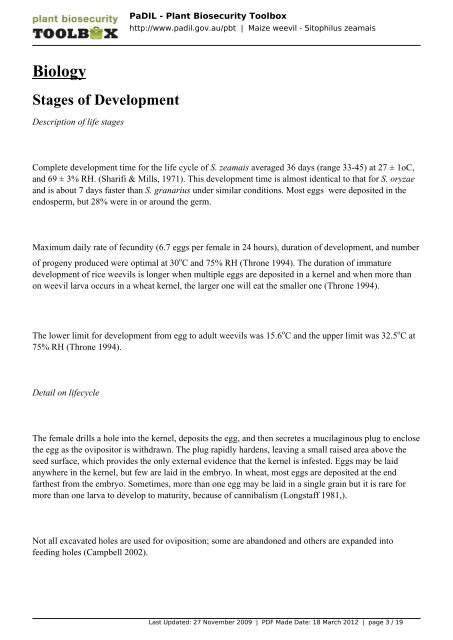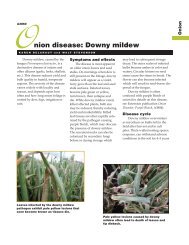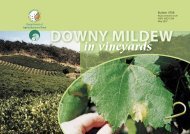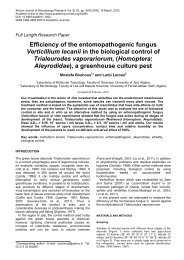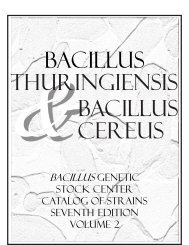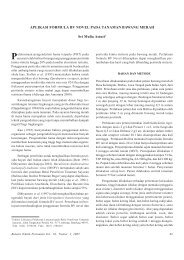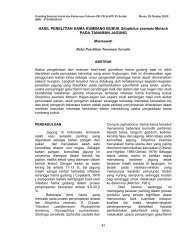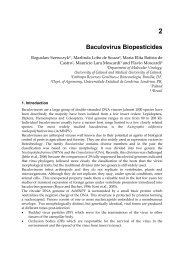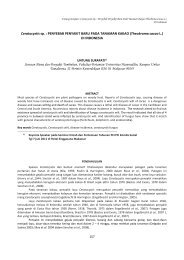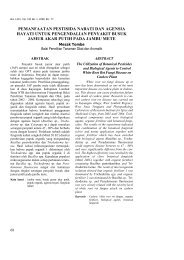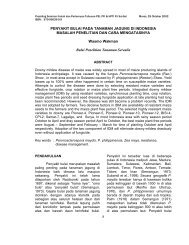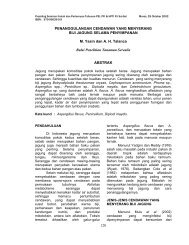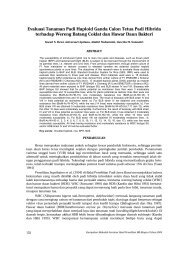Maize weevil - Sitophilus zeamais
Maize weevil - Sitophilus zeamais
Maize weevil - Sitophilus zeamais
You also want an ePaper? Increase the reach of your titles
YUMPU automatically turns print PDFs into web optimized ePapers that Google loves.
PaDIL - Plant Biosecurity Toolboxhttp://www.padil.gov.au/pbt | <strong>Maize</strong> <strong>weevil</strong> - <strong>Sitophilus</strong> <strong>zeamais</strong>BiologyStages of DevelopmentDescription of life stagesComplete development time for the life cycle of S. <strong>zeamais</strong> averaged 36 days (range 33-45) at 27 ± 1oC,and 69 ± 3% RH. (Sharifi & Mills, 1971). This development time is almost identical to that for S. oryzaeand is about 7 days faster than S. granarius under similar conditions. Most eggs were deposited in theendosperm, but 28% were in or around the germ.Maximum daily rate of fecundity (6.7 eggs per female in 24 hours), duration of development, and numberof progeny produced were optimal at 30 o C and 75% RH (Throne 1994). The duration of immaturedevelopment of rice <strong>weevil</strong>s is longer when multiple eggs are deposited in a kernel and when more thanon <strong>weevil</strong> larva occurs in a wheat kernel, the larger one will eat the smaller one (Throne 1994).The lower limit for development from egg to adult <strong>weevil</strong>s was 15.6 o C and the upper limit was 32.5 o C at75% RH (Throne 1994).Detail on lifecycleThe female drills a hole into the kernel, deposits the egg, and then secretes a mucilaginous plug to enclosethe egg as the ovipositor is withdrawn. The plug rapidly hardens, leaving a small raised area above theseed surface, which provides the only external evidence that the kernel is infested. Eggs may be laidanywhere in the kernel, but few are laid in the embryo. In wheat, most eggs are deposited at the endfarthest from the embryo. Sometimes, more than one egg may be laid in a single grain but it is rare formore than one larva to develop to maturity, because of cannibalism (Longstaff 1981,).Not all excavated holes are used for oviposition; some are abandoned and others are expanded intofeeding holes (Campbell 2002).Last Updated: 27 November 2009 | PDF Made Date: 18 March 2012 | page 3 / 19


